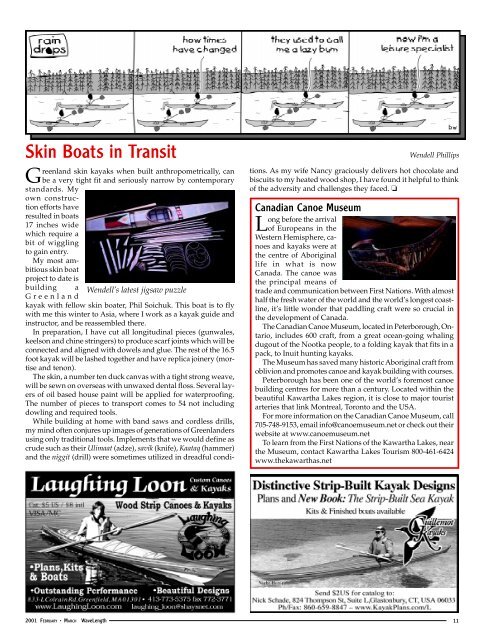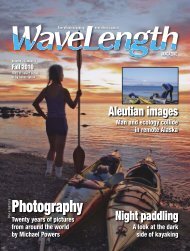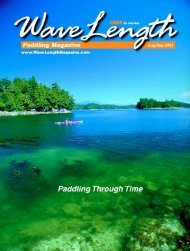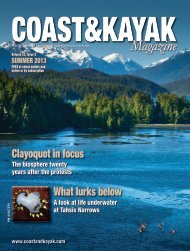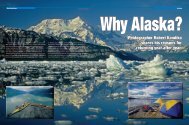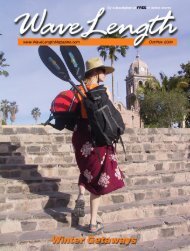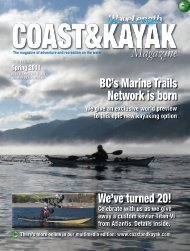Alexandra - Wavelength Paddling Magazine
Alexandra - Wavelength Paddling Magazine
Alexandra - Wavelength Paddling Magazine
Create successful ePaper yourself
Turn your PDF publications into a flip-book with our unique Google optimized e-Paper software.
Skin Boats in Transit<br />
Greenland skin kayaks when built anthropometrically, can<br />
be a very tight fit and seriously narrow by contemporary<br />
standards. My<br />
own construction<br />
efforts have<br />
resulted in boats<br />
17 inches wide<br />
which require a<br />
bit of wiggling<br />
to gain entry.<br />
My most ambitious<br />
skin boat<br />
project to date is<br />
building a<br />
Greenland<br />
kayak with fellow skin boater, Phil Soichuk. This boat is to fly<br />
with me this winter to Asia, where I work as a kayak guide and<br />
instructor, and be reassembled there.<br />
In preparation, I have cut all longitudinal pieces (gunwales,<br />
keelson and chine stringers) to produce scarf joints which will be<br />
connected and aligned with dowels and glue. The rest of the 16.5<br />
foot kayak will be lashed together and have replica joinery (mortise<br />
and tenon).<br />
The skin, a number ten duck canvas with a tight strong weave,<br />
will be sewn on overseas with unwaxed dental floss. Several layers<br />
of oil based house paint will be applied for waterproofing.<br />
The number of pieces to transport comes to 54 not including<br />
dowling and required tools.<br />
While building at home with band saws and cordless drills,<br />
my mind often conjures up images of generations of Greenlanders<br />
using only traditional tools. Implements that we would define as<br />
crude such as their Ulimaat (adze), savik (knife), Kaataq (hammer)<br />
and the niggit (drill) were sometimes utilized in dreadful condi-<br />
2001 FEBRUARY • MARCH WaveLength<br />
Wendell’s latest jigsaw puzzle<br />
Wendell Phillips<br />
tions. As my wife Nancy graciously delivers hot chocolate and<br />
biscuits to my heated wood shop, I have found it helpful to think<br />
of the adversity and challenges they faced. ❏<br />
Canadian Canoe Museum<br />
Long before the arrival<br />
of Europeans in the<br />
Western Hemisphere, canoes<br />
and kayaks were at<br />
the centre of Aboriginal<br />
life in what is now<br />
Canada. The canoe was<br />
the principal means of<br />
trade and communication between First Nations. With almost<br />
half the fresh water of the world and the world’s longest coastline,<br />
it’s little wonder that paddling craft were so crucial in<br />
the development of Canada.<br />
The Canadian Canoe Museum, located in Peterborough, Ontario,<br />
includes 600 craft, from a great ocean-going whaling<br />
dugout of the Nootka people, to a folding kayak that fits in a<br />
pack, to Inuit hunting kayaks.<br />
The Museum has saved many historic Aboriginal craft from<br />
oblivion and promotes canoe and kayak building with courses.<br />
Peterborough has been one of the world’s foremost canoe<br />
building centres for more than a century. Located within the<br />
beautiful Kawartha Lakes region, it is close to major tourist<br />
arteries that link Montreal, Toronto and the USA.<br />
For more information on the Canadian Canoe Museum, call<br />
705-748-9153, email info@canoemuseum.net or check out their<br />
website at www.canoemuseum.net<br />
To learn from the First Nations of the Kawartha Lakes, near<br />
the Museum, contact Kawartha Lakes Tourism 800-461-6424<br />
www.thekawarthas.net<br />
11


